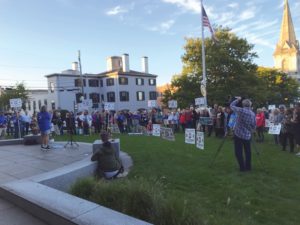PLYMOUTH — Holtec Decommissioning International, the company that now owns the former Pilgrim Nuclear Power Station, has announced it will extend its timeline for the potential release of 1.1 million gallons of radioactive water into Cape Cod Bay.

The reason Holtec gave for the reprieve at the Nuclear Decommissioning Citizens Advisory Panel (NDCAP) meeting on Monday was that it plans to use the water from its spent fuel pool, reactor cavity, and other systems to shield workers who are dismantling radioactive components. The work is done remotely, with machinery placed under water to prevent parts from emitting radiation into the air. The work is expected to continue until the first quarter of 2023.
More than 100 residents and members of the fishing and tourism industries rallied in front of Plymouth Town Hall on Monday before packing a meeting of NDCAP, a group established to offer guidance on the dismantling of the Pilgrim plant.
Public opposition to a proposed release of the water into the bay has been building since last November, when Holtec announced its plan. In reaction, Holtec at first agreed to consider other options, including storing the contaminated water on-site, evaporating it, or trucking it to a licensed disposal facility.
But Holtec’s president, Kris Singh, has repeatedly made it clear that releasing the water into the bay is his preferred option. He told U.S. Sen. Ed Markey in a letter in June that trucking it away is off the table because of the company’s commitment to environmental justice — meaning it would be fairer to have the waste disposed of here rather than in another place. Opponents have argued that other places are less environmentally sensitive and already set up as disposal sites.
Moving the water would be expensive; it carries a price tag of $20 million, Singh said. He also said evaporation involved high heat that would probably require the use of diesel generators. But keeping the water stored on-site could delay decommissioning.
Singh committed to allowing the water to be tested by an independent lab during a congressional hearing Sen. Markey held in Plymouth in May. According to the senator’s office, Markey has secured an agreement to allow the Mass. Dept. of Public Health (DPH) to be present during testing and to get samples for independent analysis by the agency.
David Noyes, senior compliance manager for Holtec, announced that commitment during Monday’s meeting. Noyes said the company would allow the DPH to sample the water in the spent fuel pool, reactor cavity, and other systems before it is filtered to remove some of the contaminants. This could be done incrementally as the water is used over the next four or five months, if DPH prefers, and following treatment if the option to release the water into Cape Cod Bay is chosen.
Noyes said Holtec would give a presentation at the November NDCAP meeting revealing what other contaminants — nonradioactive ones — are found in Pilgrim’s water. He said historical data on the radioactive elements that would be present would also be shared. Using current data is not practical because the water is still in use and its radioactive levels could change, he said.
A Holtec scientist, James Conca, on Monday tried to assure the public that there is no scientific evidence tritium causes harm. The radionuclide, present in the 1.1 million gallons, binds to water and cannot be filtered out. “Perception is the problem,” Conca said, defending the safety of the radioactive water the company wants to release.
Many observers remained unconvinced.
“The bottom line is it costs $20 million to legally transport this,” shouted Duxbury charter boat owner Peter Dalton from the audience. “It’s going into Dr. Singh’s pocket, and it’s screwing all of us fishermen and lobstermen.”
Conca agreed with Woods Hole oceanographer Irina Rypina, who has said that a discharge from the plant would be carried by bottom currents that flow south, splitting at Race Point, with some of it stalling along the shoreline of Cape Cod and the rest hugging the coast of the Outer Cape. The water that would flow into the bay would stall in the mid-Cape area for several days, Rypina said.
Conca agreed it would be important to avoid that. “The idea is to work with the Woods Hole folks on when and how to release the water when the current is flowing north,” Conca said. That comment drew grumbling opposition from those living north of the plant.
During the meeting, Noyes was asked by panel member Henrietta Cosentino why Holtec continues to consider releasing the water into the bay “when it’s against the law.” He answered that “if it is determined to be illegal, we will not discharge the water.”
James Lampert, a Duxbury attorney and outspoken opponent of the water release, said it would be illegal under both federal and state law because there are nonradioactive pollutants in the water that would not comply with the discharge permit issued by the federal Environmental Protection Agency and the state Dept. of Environmental Protection.
Furthermore, Lampert said, the Mass. Ocean Sanctuary Act prohibits dumping or discharging commercial or industrial waste into an ocean sanctuary. “Cape Cod Bay, Plymouth Bay, Duxbury Bay, and Kingston Bay are all ocean sanctuaries,” he added.
The Duxbury attorney noted that Attorney General Maura Healey has said she will prevent Holtec from dumping the water.
In a written statement released Monday, a spokesperson for the attorney general repeated previous communications on Healey’s stance: “Our office will do everything possible to hold Holtec accountable and ensure public health and safety throughout the decommissioning process. We are prepared to take action to halt any violations of state and federal water discharge permits.”



